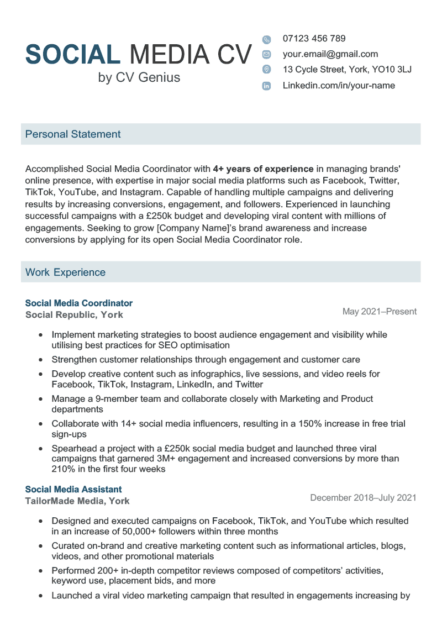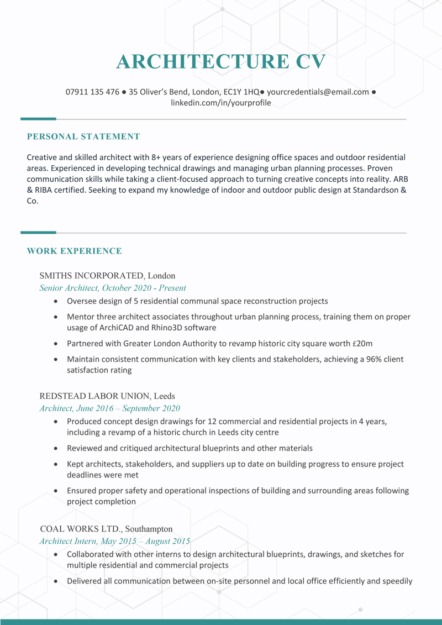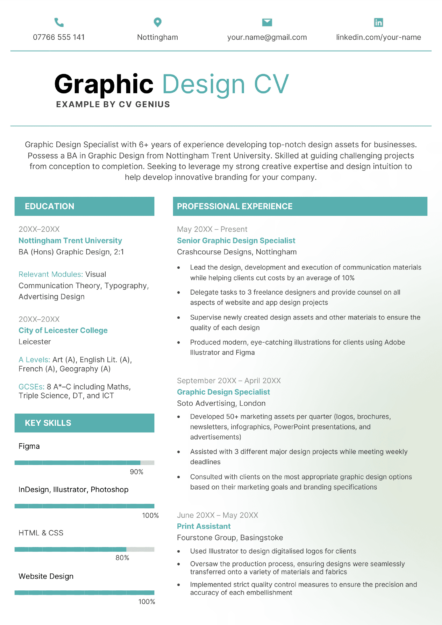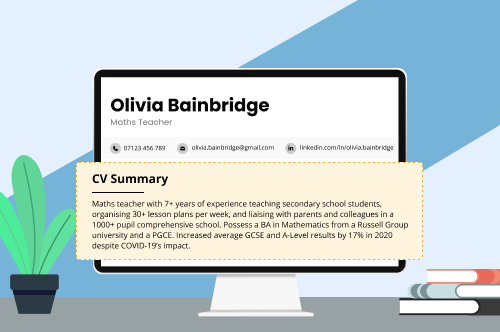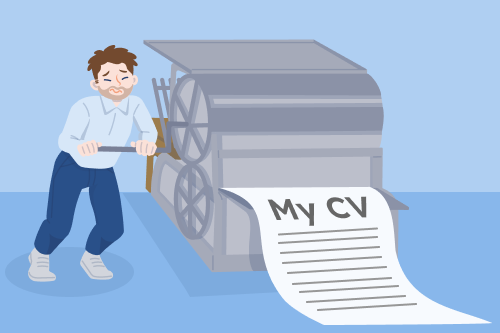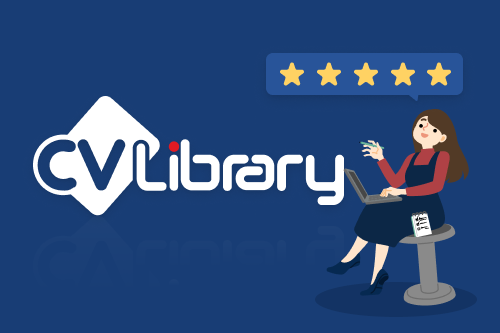Ensure your CV layout is structured to best highlight your unique experience and life situation.
Designer CV Template (Text Format)
PERSONAL STATEMENT
Dynamic and detail-oriented UI/UX Designer with 9 years of experience in creative design projects from concept development to the final product. Highly capable of accelerating brand popularity by using creative skills to help drive company success. Seeking a UI/UX Designer position with [Company Name] to enhance your product designs and create meaningful experiences for users.
WORK EXPERIENCE
Goldhammer Creatives, Newport
Senior UI/UX Designer, May 2018–Present
- Spearheaded 100+ user-centred designs to boost brand development, which resulted in a 37% increase in sales
- Handle creative conceptualisation, development, and final designs of products
- Lead a design team of 8 members to accomplish all product design targets
- Create mobile application and responsive design content for clients, which has generated a 60% increase in online engagement
- Manage design budgets efficiently and developed a new budgeting system that led to cost savings of 9%
Blackbox Media and Design, Newport
UI/UX Designer, June 2014–April 2018
- Composed social media marketing designs for the company, including advertisements and infographics, which helped the brand garner 600,000+ likes
- Coordinated with clients, creative teams, and printers to produce derivable posters and art prints for 20+ projects
- Managed 8 client accounts with additional weekly deadlines
- Liaised with 100+ clients and businesses to achieve their product design goals, achieving a 95% client satisfaction rate
EDUCATION
University of South Wales (2010–2013)
BA (Hons) Graphic Communication, Upper second-class honours (2:1)
- Relevant Modules: Visualisation for Communication, User Experience Design, Data Stories and Infographics, Change by Design
- Research Project: Graphic Design Trends in the 21st Century
Newport High School, Newport (2003–2010)
- A-levels: Art (A), English (A), Maths (B)
- GCSEs: 10 A-C including Maths, English, Combined Science, and Art
KEY SKILLS
- Figma, Adobe XD, Zeppelin, Sketch
- Typography
- Print design
- UX writing
- Adobe Photoshop, Dreamweaver, InDesign, and Illustrator
- HTML and CSS
- Responsive design
- Interaction design
- Information architecture
- Time management
- UX research
- Visual storytelling
HOBBIES & INTERESTS
- Painting
- Photography
- Visiting art galleries
- Social media
How to write a designer CV
Before you begin writing, make sure you know how to write a CV in a way that best emphasises your strengths.
As a UI/UX designer, your portfolio should highlight your experiences enhancing user journeys through good design. But companies hiring a new designer will look at your CV first to see if you meet their job requirements. So write an attention-grabbing designer CV that gives them a reason to continue reading the rest of your application.
Here are four tips to write a designer CV that earns you an interview:
1. Use a tidy designer CV format
Impressing employers means presenting them with a visual CV that speaks to your eye for detail. So as you’re formatting your UI/UX designer CV, pay attention to your fonts and CV layout.
First, fancy fonts are eye-catching, but don’t overuse them in your designer CV because they can be difficult to read. Instead, the best font for your CV should be a classic style like Times New Roman or Cambria, or go for a minimalist option like Calibri or Arial.
The colours you use for your fonts also have the potential to enhance your designer CV — or distract your reader. So stick with two to three colours and make sure they contrast well against your background.
Try using a preformatted CV template to save you time, so you can focus on determining the best achievements to put on your CV.
Also, lay out your designer CV so it conveys your relevant information without seeming too busy. An effective way to utilise white space on your CV is with bulleted lists. Including a neat list of bullet points makes your statements easy to read and ensures employers can focus on the most significant points of your CV.
And if you already have some experience in product design, a reverse chronological CV layout works best. This type of resume lists your work experience on the first page, starting with the most recent. Then, your CV education section, additional skills, and hobbies and interests can go on the second page.
2. Compose a persuasive designer CV personal statement
Your designer CV personal statement is the first thing recruiters see after your personal information, so take advantage of this section by writing 2–4 sentences outlining your top qualifications and experience.
Because the personal statement on your designer CV is only a few lines long, try thinking about it in sections so you can cover all the important points.
- First, begin the first sentence with one or two of your most outstanding and design-related skills or achievements to set a confident and positive tone.
- In the next sentence, tell the recruiter about the skills, experience, or qualifications you think they’ll value most. For instance, you can briefly mention the type of design work you’ve done, the kind of clients you’ve worked for, or specific software you’re adept at using.
- The last line of your personal statement should describe what you’re looking for from your next position and how you’d contribute to their company if hired. So research the business and show how your objectives align with their work and values.
Here’s an example of a persuasive design CV personal statement:
Dedicated and visually driven UX Designer with 7 years of experience in advertising and product planning. Possess a BA degree in Media Arts. Hold an Adobe Associate certification. Comfortable supporting businesses from initiating concepts to the final product. Seeking a position at Landonbuzz to enhance the visibility of your brand’s online presence.
3. Highlight your designer CV skills
Designers often work with people who prefer a unique outcome for their product. In this case, you’ll need to master using various design software programs and working with different people, all of which relies on your hard and soft skills.
Your hard skills are technical abilities you learned from studying and practical experience. These technical skills let employers know what you can do and if you’re a good fit for the job.
Here are examples of important hard skills for designers:
- Collaborative interface tools such as Figma, Adobe XD, Zeppelin
- Graphics or photo imaging and editing software, such as Adobe Illustrator
- Freehand sketching
- Knowledge of wireframe tools (e.g., InVision, Wireframe.cc)
Equally important are your soft skills, which are the personality traits affecting how you work with your clients and colleagues.
Soft skills are essential as a designer, not just for your creativity, but also so you can understand your client’s expectations and discuss different options with them.
These are some examples of soft skills for a designer CV:
- Creative thinking
- Active listening
- Negotiation
- Communication skills
- Time management
- Attention to detail
- Teamwork
Besides your CV skills section, try to illustrate your soft skills in your work experience section so the recruiter can see how you used these skills to improve your work outcomes.
Here are some examples of a UX designer applicant’s communication skills:
4. Use impactful numbers in your designer CV work experience section
Recruiters already have a profile in mind for the UI/UX designer they aim to hire, so your designer CV work experience section should show you’re the best candidate among all the applicants.
Describe the impact you’ll bring to your target company by including hard numbers (e.g., percentages, pounds, number of people, projects) when talking about your achievements.
For example, have your landing page designs increased a company’s sales? If so, mention the percentage.
Did an infographic campaign you created go viral? Then, tell the reader how many people it reached or how many interactions it achieved.
By quantifying your achievements, you give the employer a realistic picture of what their company might achieve with you on the team.
We’ve highlighted some hard numbers below as examples of how a UI/UX designer illustrates their achievements:
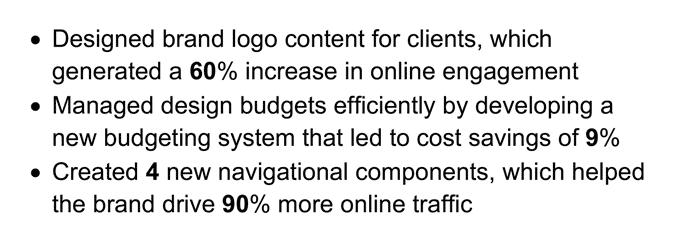
Still a bit overwhelmed? Use an online CV builder that’ll create your CV in just a few minutes. You can also use an online cover letter builder to create a matching cover letter.

